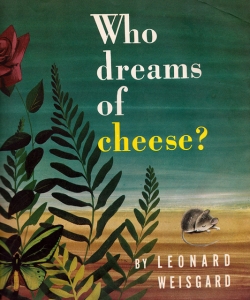2018 School Spending Survey Report
Artist’s Choice
An illustrator comments in each issue of The Horn Book upon a new picture book he particularly likes.
An illustrator comments in each issue of The Horn Book upon a new picture book he particularly likes.
 Who Dreams of Cheese?
Who Dreams of Cheese?comment by Elizabeth Orton Jones
Who can draw dreams? Who can draw thoughts? Who can tell with a few words and a paint brush how it feels to be a bird — so aptly and simply that suddenly we are a bird? We never really knew before how it was to fly — to peck quickly at a grape with a sharp bill — to be afraid of a squirrel. But now, somehow, we do. And with this knowing comes a new ableness to feel, through our whole being, the meaning of that nest, deep in the weeds, with eggs in it. We feel and we dream a bird’s dream. And having felt and dreamed, we are now part bird. And this moment of experience will never leave us. This bit of understanding is ours, to keep. Who can give such a gift?
We turn to the next page, in the picture book of my choice. Who dreams of a picture book wherein we can be completely reconciled to that disconcerting necessity of going from color to black and white and back again? How reconciled? By our acceptance of the simple fact that there are all kinds of dreams: big and little, funny and sad, dark and light, color and gray —. Instead of black, however, brown is used here — the warm brown of a warm brown blanket…Just as we became a bird, now we are a mouse. And now we know who dreams of cheese.
We were asked this question very loudly, in huge letters, on the front of the jacket — CHEESE being an almost screeching yellow which didn’t seem to go, quite, with the mood of the whole. It was like a gaudy trumpet-call used to introduce a most tender piece of music. Perhaps tenderness needs such a call to attention…“Who dreams of CHEESE?”…“Come into my book,” said Leonard Weisgard, humbly, in small letters, down at the bottom, “and you will see.”…It was an invitation we could not refuse.
We opened the book and its mood came out to meet us. Like a dream it enfolded us and carried us easily — oh! so easily — on.
Direct brush strokes, a feeling of freshness and transparency everywhere, an ingenious background treatment, words that sound like the pictures and pictures that look like the words—all merge and lose themselves in what seems the essence of dreams. We become a rabbit — a fox — a pony — a squirrel — a fish under water — a boy — a girl. We peck we scamper, we nibble, we laugh, in this series of transforming experiences. It’s all such fun we scarcely realize that with each one we grow, until we are big enough to know the grown-up dreams of a father, a mother. And finally, we seem to be everything at once — everything we have been, in the book, and everything we are going to be, outside, in life. It is a big feeling. And underneath — deep underneath — is a bigger feeling still.
“What I see here is nothing but a shell,” the Little Prince told us, several years ago. “What is important is invisible.”
There is a gratifying trend — I might almost say compulsion — which has entered into the making of picture books today: to use the tangible as a transparency, a lens, through which to look and find the intangible, the invisible, the really real.
We close the book. On the back of the jacket is a slender moon, and soft streaks of paint which look like the layers of sleep, and some translucent ferns, and two white daisies growing on invisible stems.
Shall we turn the book over and begin again? The children will want to, I know.
This article, originally published in the November 1950 issue of The Horn Book Magazine, is part of our Caldecott at 75 celebration. Click here for more archival Horn Book material on Elizabeth Orton Jones and Prayer for a Child.
RELATED
RECOMMENDED
ALREADY A SUBSCRIBER? LOG IN
We are currently offering this content for free. Sign up now to activate your personal profile, where you can save articles for future viewing.






Add Comment :-
Be the first reader to comment.
Comment Policy:
Comment should not be empty !!!